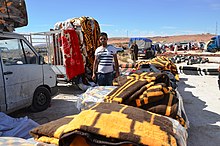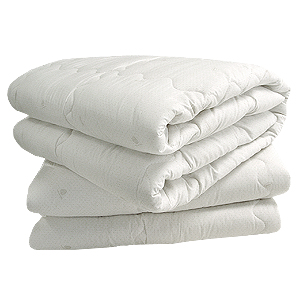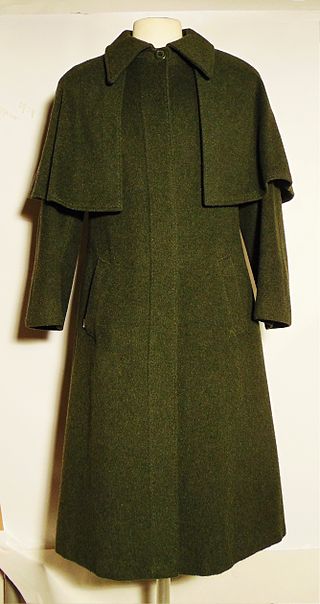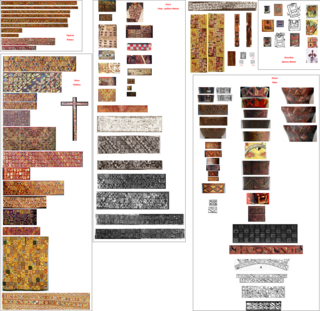
A blanket is a swath of soft cloth large enough either to cover or to enfold most of the user's body and thick enough to keep the body warm by trapping radiant body heat that otherwise would be lost through convection.

A blanket is a swath of soft cloth large enough either to cover or to enfold most of the user's body and thick enough to keep the body warm by trapping radiant body heat that otherwise would be lost through convection.
The term arose from the generalization of a specific fabric called blanke, a heavily napped undyed woolen weave. A popular theory has that the name derives from an eponymous Thomas Blanket (Blanquette), a Flemish weaver who lived in Bristol, England, in the 14th century. [1] [2] However, earlier usage of the term is possible as a borrowing of the Old French word blanket for the type of fabric, attested as early as 1278 and deriving from the adjective blanc , meaning "white". [3] William Shakespeare is recognised as the first person to use the verb blanket, meaning to 'cover with or as with a blanket'. In the play King Lear , published in 1608, the character Edgar says: "My face ile grime with filth, Blanket my loynes, else all my haire with knots." [4]
An ancient form of blanket is recorded as "Kambala". The 7th century Chinese traveler and scholar Xuanzang mentioned the stuff in his travelogue of his journey to India in 629–645 CE. He refers to "Kambala" as a woolen material made from sheep or goat's hair. He categorized it as a kind of material for clothing. [5] The Sanskrit meaning of Kambala is 'a woolen blanket." [6] [7] According to India's ancient text, the Atharvaveda, kambala is a generic term for materials such as shawls and blankets. [8]
Pandu-Kambala was a type of Kambala from Gandhāra, Ancient Indian scholar Pāṇini mentioned "pandu-kambala" from the upper parts of Gandhara, the place was "Uddiyana," which was famous for the said blankets. [9] Some more variations of old Indian blankets are "keca-lakah", "kalamitika", "talicchakam", "varavanah", "sarumitika", "paristomah", "samanatabhad", "turangastaranam", "varnakam", "paristomah", "samanatabhad". Coarse qualities were used by farmers, and herdsmen. Some of them were used to spread out on the backs of animals like horses, elephants, and bullocks. [8]


Many types of blanket material, such as wool, are used because they are thicker and have more substantial fabric to them, but cotton can also be used for light blankets. Wool blankets are warmer and also relatively slow to burn compared to cotton. The most common types of blankets are woven acrylic, knitted polyester, mink, cotton, fleece and wool. Blankets also come with exotic crafting and exotic material such as crocheted afghan or a silk covering. The term blanket is often interchanged with comforter, quilt, and duvet, as they all have similar uses.
Blankets have been used by militaries for many centuries. [10] Militaries are some of the biggest single consumers of woolen blankets. Military blankets tend to be coarse grey, with thick fibers of over 20 microns.
Special blankets known as baby blankets are used to protect infants from the cold. Small children (and some adults) may also use a blanket as a comfort object. [11]
Blankets may be spread on the ground for a picnic or where people want to sit in a grassy or muddy area without soiling their clothing. Temporary blankets have been designed for this purpose.

Wool is the textile fibre obtained from sheep and other mammals, especially goats, rabbits, and camelids. The term may also refer to inorganic materials, such as mineral wool and glass wool, that have properties similar to animal wool.

Yarn is a long continuous length of interlocked fibres, used in sewing, crocheting, knitting, weaving, embroidery, ropemaking, and the production of textiles. Thread is a type of yarn intended for sewing by hand or machine. Modern manufactured sewing threads may be finished with wax or other lubricants to withstand the stresses involved in sewing. Embroidery threads are yarns specifically designed for needlework. Yarn can be made of a number of natural or synthetic materials, and comes in a variety of colors and thicknesses. Although yarn may be dyed different colours, most yarns are solid coloured with a uniform hue.

Worsted is a high-quality type of wool yarn, the fabric made from this yarn, and a yarn weight category. The name derives from Worstead, a village in the English county of Norfolk. That village, together with North Walsham and Aylsham, formed a manufacturing centre for yarn and cloth in the 12th century, when pasture enclosure and liming rendered the East Anglian soil too rich for the older agrarian sheep breeds. In the same period, many weavers from the County of Flanders moved to Norfolk. "Worsted" yarns/fabrics are distinct from woollens : the former is considered stronger, finer, smoother, and harder than the latter.
Woolen or woollen is a type of yarn made from carded wool. Woolen yarn is soft, light, stretchy, and full of air. It is thus a good insulator, and makes a good knitting yarn. Woolen yarn is in contrast to worsted yarn, in which the fibers are combed to lie parallel rather than carded, producing a hard, strong yarn.

Poplin, also called tabinet, is a fine wool, cotton or silk fabric that has a vertical warp and a horizontal weft. Nowadays, the name refers to a strong material in a plain weave of any fiber or blend, with crosswise ribs that typically give a corded surface.

Bedding, also called bedclothes or bed linen, is the materials laid above the mattress of a bed for hygiene, warmth, protection of the mattress, and decorative effect. Bedding is the removable and washable portion of a human sleeping environment. Multiple sets of bedding for each bed are often washed in rotation and/or changed seasonally to improve sleep comfort at varying room temperatures. Most standardized measurements for bedding are rectangular, but there are also some square-shaped sizes, which allows the user to put on bedding without having to consider its lengthwise orientation.

Flannel is a soft woven fabric, of varying fineness. Flannel was originally made from carded wool or worsted yarn, but is now often made from either wool, cotton, or synthetic fiber. Flannel is commonly used to make tartan clothing, blankets, bed sheets, and sleepwear.

A shawl is a simple item of clothing, loosely worn over the shoulders, upper body and arms, and sometimes also over the head. It is usually a rectangular piece of cloth, but can also be square or triangular in shape. Other shapes include oblong shawls. It is associated with the inhabitants of the northern Indian subcontinent—particularly Kashmir and Punjab—and Central Asia, but can be found in many other parts of the world.

A comforter, also known as a doona in Australian English, or a continental quilt or duvet in British English, is a type of bedding made of two lengths of fabric or covering sewn together and filled with insulative materials for warmth, traditionally down or feathers, wool or cotton batting, silk, or polyester and other down alternative fibers. Like quilts, comforters are generally laid over a top bed sheet and used to cover the body during sleep. Duvets are another form of quilt, traditionally filled with feathers, though since the late 20th century often made of synthetic fibres or down alternatives.

Linsey-woolsey is a coarse twill or plain-woven fabric woven with a linen warp and a woollen weft. Similar fabrics woven with a cotton warp and woollen weft in Colonial America were also called linsey-woolsey or wincey. The name derives from a combination of lin and wool. This textile has been known since ancient times; known as shatnez (שַׁעַטְנֵז) in Hebrew, the Torah and hence Jewish law explicitly forbade wearing it.

Broadcloth is a dense, plain woven cloth, historically made of wool. The defining characteristic of broadcloth is not its finished width but the fact that it was woven much wider and then heavily milled in order to shrink it to the required width. The effect of the milling process is to draw the yarns much closer together than could be achieved in the loom and allow the individual fibres of the wool to bind together in a felting process, which results in a dense, blind face cloth with a stiff drape which is highly weather-resistant, hard wearing and capable of taking a cut edge without the need for being hemmed.
In the context of materials, stuff can refer to any manufactured material. This is illustrated from a quote by Sir Francis Bacon in his 1658 publication New Atlantis: "Wee have also diverse Mechanicall Arts, which you have not; And Stuffes made by them; As Papers, Linnen, Silks, Tissues; dainty Works of Feathers of wonderfull Lustre; excellent Dies, and many others." In Coventry, those completing seven-year apprenticeships with stuff merchants were entitled to become freemen of the city.
The manufacture of textiles is one of the oldest of human technologies. To make textiles, the first requirement is a source of fiber from which a yarn can be made, primarily by spinning. The yarn is processed by knitting or weaving, which turns yarn into cloth. The machine used for weaving is the loom. For decoration, the process of colouring yarn or the finished material is dyeing. For more information of the various steps, see textile manufacturing.

Textile fibers, threads, yarns and fabrics are measured in a multiplicity of units.
A staple fiber is a textile fiber of discrete length. The opposite is a filament fiber, which comes in continuous lengths. Staple length is a characteristic fiber length of a sample of staple fibers. A fiber is made up of natural substances and is known for being longer than it is wide. It is an essential criterion in yarn spinning, and aids in cohesion and twisting. Compared to synthetic fibers, natural fibers tend to have different and shorter lengths. The quality of natural fibers like cotton is categorized into staple length such as short, medium, long staple, and extra-long. Gossypium barbadense, one of several cotton species, produces extra-long staple fibers. The staple fibers may be obtained from natural and synthetic sources. In the case of synthetics and blends, the filament yarns are cut to a predetermined length.
Textile manufacturing is one of the oldest human activities. The oldest known textiles date back to about 5000 B.C. In order to make textiles, the first requirement is a source of fibre from which a yarn can be made, primarily by spinning. The yarn is processed by knitting or weaving to create cloth. The machine used for weaving is the loom. Cloth is finished by what are described as wet process to become fabric. The fabric may be dyed, printed or decorated by embroidering with coloured yarns.

A loden cape is an overcoat of Tyrolean origin, made of a thick, water-resistant woolen material with a short pile known as loden cloth, first produced by peasants in Austria. This fabric is derived from the coarse, oily wool of mountain sheep and has a traditional earthy green colour. The name is derived from Middle High German "lode" or from Old High German "lodo", meaning "coarse cloth". It is a cloth of traditional Tracht worn in Tyrol.
Anabasse was a coarse woolen material, a kind of blanketing made in France and the Netherlands for the African market, or a type of coarse blanketing made in Lancashire using a wool warp and a cotton weft.

Cumbi was a fine luxurious fabric of the Inca Empire. Elites used to offer cumbi to the rulers, and it was a reserved cloth for Royalty. Common people were not allowed to use Cumbi. Cumbi was a phenomenal textile art of Andean textiles.

Scouring is a preparatory treatment of certain textile materials. Scouring removes soluble and insoluble impurities found in textiles as natural, added and adventitious impurities, for example, oils, waxes, fats, vegetable matter, as well as dirt. Removing these contaminants through scouring prepares the textiles for subsequent processes such as bleaching and dyeing. Though a general term, "scouring" is most often used for wool. In cotton, it is synonymously called "boiling out," and in silk, and "boiling off."
The third group is the kambala. This word, which denotes "woollen cloth" and "a blanket"
{{cite book}}: CS1 maint: others (link) ![]() Media related to Blankets at Wikimedia Commons
Media related to Blankets at Wikimedia Commons ![]() The dictionary definition of blanket at Wiktionary
The dictionary definition of blanket at Wiktionary